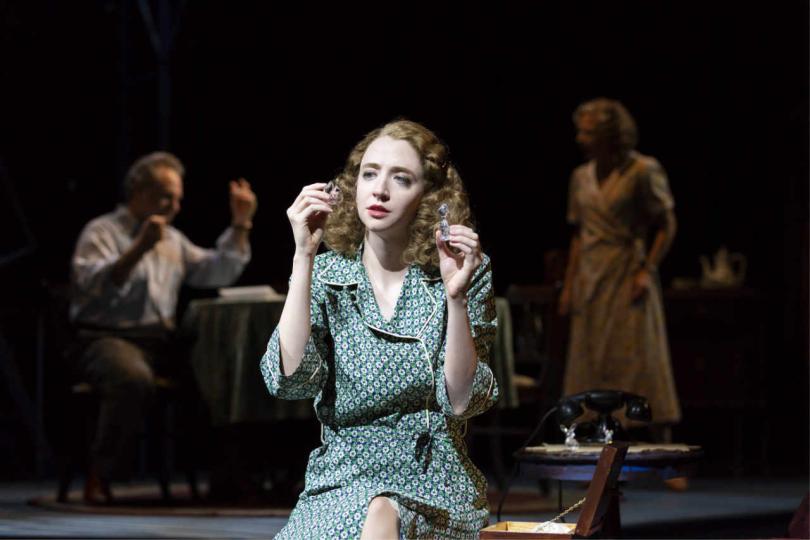The Privilege of Forgetting: Guthrie’s Outstanding Glass Menagerie

At the outset of The Glass Menagerie, before he even introduces himself, Tom Wingfield (Remy Auberjonois) says: “I have tricks in my pocket -- I have things up my sleeve.” For a moment, Tom seems merely to be summoning the old cliché of playwright (artist) as illusion-maker. But in his visionary staging of Tennessee William’s sorrowful early masterpiece, Joseph Haj makes sure that we grasp the darker implications of the lines that open the play.
Tom serves as both the narrator of a play that “is memory” and as one of its characters. When we meet him, he is looking back on the events depicted from a distance of some years. Tom speaks those opening words without a trace of irony – and slowly, so that we so that we hear the embedded warning.
A play that “is memory” will, like memory itself, be selective. Tom will use the tricks he has -- sleights of hands, even some poetry -- when it serves his purpose. He may overlook certain complicating details, some uncomfortable truths. The audience needs to exercise scrutiny.
As usual, Haj’s directorial hand is invisible. He is one of the least flashy directors around, never calling attention to the innovations he brings to a work. Still, anyone who has some familiarity with this play can hardly fail to notice how much is new, even revolutionary, about the present Glass Menagerie. It is a momentous production, which should not be missed.
Haj has an uncanny ability to make us hear all the levels of a play at once. Without ever taking us out of Tom’s narrative – the story he wants to tell -- Haj keeps us attuned to the plays’ resistance to that narrative. Haj’s greatest innovation here is to decenter Tom. This deepens our awareness of the ambiguities of his character and enables us sympathetically to identify with each of the play’s four characters. Haj’s casting is inspired; all the actors turn in astonishing performances; and all four characters are brought to life as damaged, needy but still vibrant individuals. One of the most delightful results is that for once we are given an Amanda Wingfield (Jennifer Van Dyck) who is not a stereotype of a “witch[y]” (Tom’s word), suffocating mother. Van Dyck’ s Amanda is a full-blooded, emotionally and intellectually complex person, a woman who, like her son, Tom, and like her daughter, Laura Wingfield (Carey Cox), is struggling to find some small share of beauty in a dark world. Van Dyck delivers a magisterial performance, in which Amanda’s resilience and multi-dimensionality is fully realized.
Because Auberjonois and Van Dyck read as being around the same age, we are made to notice how much they resemble one another. Mother and son share the same droll wit, and both are romantics. Amanda is a storyteller like Tom, and all three Wingfields are artists. Amanda's puritanism -- she returns Tom’s copy of Sons and Lovers to the public library -- is a response to the disastrous consequences she had suffered by having briefly indulged in her youth her (Tom-like) appetite for adventure. Van Dyck captures the lyricism, the sheer musicality, of Amanda’s speech (and her dialect work is excellent). If “The Glass Menagerie” is a symphony, Amanda is lead cello, and Van Dyck is Pablo Casals.
Auberjonois is terrific, too. Notice the way he physicalizes the passage of time. He gives the young Tom a jauntiness and nervous energy; when he switches to Tom the narrator, his posture alters. We see his shoulders sag, as if weighted with care. Grayson DeJesus gives us a Jim O’Connor, the “gentleman caller,” who is not merely as the embodiment of some generic niceness, but rather someone who has had to fight for his optimism. And Carey Cox is outstanding as Laura Wingfield, bringing exquisite vulnerabilities to the role, while overlaying it with dignified restraint.
One of Tom’s first “tricks” is to diminish what he calls “the social background” of his story: the monumental devastations and indignities of the Great Depression. However, the economic privation of the time is clearly central to the play’s events. The story Tom wants to tell is a Bildungsroman: the struggles of a sensitive young (would-be) writer, whose spirit is being crushed by a mind-numbing job at a shoe factory and a smothering, overbearing mother. Tom’s father, “a telephone man who fell in love with long distance,” deserted the family, and Tom has been thrust into the position of breadwinner at the age of 24. He tries to write poems during breaks at work and at home on the kitchen table, but the flat is crowded. To escape the sense of suffocation, he goes to the movies. Tom’s sense of confinement is evoked by Mikiko Suzuki MacAdams’s massive three-level fire escape at the back of the stage: the endless rows of metal slats and rails suggesting the bars of a prison. Tom does not want to be like his “bastard” father, but, to save his soul, to save his art, he may have to make difficult choices.
But there is another story which we piece together from the comments and observations of other characters, one that foregrounds money concerns. Displaced from her social background, Amanda is a woman without significant marketable skills; she is single-parenting an adult child with disabilities; and her husband has left the family penniless. She has already pawned almost all of her wedding silver and the local grocer is getting fed up with her purchasing necessities, like butter, on credit. They are barely scraping by on the sixty-five dollars Tom brings home each month. Amanda supplements the family income by demonstrating “brassieres” – humiliating work – in a local clothing store, and later in the play she takes on a second job trying to sell magazine subscriptions by phone. She apparently does all the cooking and cleaning and sewing. She is not oblivious to Tom’s frustrations. But jobs are scarce and Tom is the only member of the family who can earn a living wage.
Haj does (rare) justice to the profound complexity of this play in making us see the maze of facts, denials, and harsh material realities that underpin the family dynamic Tom depicts. In affording credibility to Amanda’s incursions of mundane need, he reveals the strain in the story Tom tries to tell.
Williams’ great theme is the necessity for illusions in order to withstand the brutalities of modern life, and the consequent dangers poses for the creators of those illusions and their loved ones. IN None of the Wingfields is whole enough to deal with the reality – or to forfeit the illusions they have put in its place. For most of the play, Amanda refuses to see or acknowledge her daughter’s limitations. Laura has a mobility impairment: she limps and uses a cane. But it is not her physical disability which makes her unable to complete a course in business school or which leaves her generally unemployable. Rather it is her terror of being seen and judged by other people. So excessive is her social anxiety that she ends up confining herself to the flat, spending her day listening to old records and playing with her collection of miniature glass animals, the “menagerie” of the title. About Laura’s incapacity to function in the world, Tom has no illusions. Yet when Amanda offers him a deal -- he can leave if he can find “somebody to take your place” (by which she means a husband for Laura) – Tom does not insist upon the implausibility of the scheme. It is characteristic of this brilliant, provotive production not to allow us to elide hard questions - like why Tom consents to invite “some nice young man from the warehouse” to dinner (as a potential candidate) when he knows that it risks endangering Laura, subjecting her to the kind of humiliation that will push her to recede further into her private world?
This is my fourth Menagerie, and I have never seen a Second Act that was this suspenseful or grasped the significance of the crucial scene in which Tom and Jim share a cigarette on the fire escape. Tom explains why he is “tired of the movies”:
“Hollywood characters are supposed to have all the adventures for everybody in America. While everybody in America sits in a dark room and watches them having it! Yes, until there’s a war. That’s when adventure becomes available to the masses! Everyone’s dish, not only Gables! Then the people in the dark room come out the dark room to have some adventures themselves -- goody goody! It’s our turn now to go the South Sea Island -- to make a safari -- to be exotic, far off… But I’m not patient. I don’t want to wait till then.”
It takes us a moment to take in Tom’s hubris, and the full measure of the mercenary sensibility that rationalizes sacrifice. When they return to the apartment, the veil drops; the depth of Tom’s cynicism is apparent in the elaborate chivalry he shows to Amanda. Haj keeps all the balls in the air in the complicated dinner scene. As Amanda carries on and Jim obliges, Auberjonois exudes an awful gleefulness. We see Cox , as Laura, who has retired.to the living room, downstage. She is not passively contemplating the glass figures but actively creating a spectral world. We see Cox animating the animals, mouthing words, enacting whole conversation between them. She “gallops” them through the air to land on the edge of the sofa. Lighting designer Christopher Akerlind creates a terrifying effect, as large blotches of flossy light, shapeless reflections of the flying-glass figures, circle the stage. The impression is of the sphere of Laura’s imagination expanding, pushing against the boundaries of her perception.
Perhaps Haj was seeking to resurrect some of the resonance the play must have had when it first opened in Chicago in 1944. By that time, the American dream had already died a thousand deaths on America’s stages. The war would last another year and claims to artistic privilege -and Tom’s “sentimental” tale about young artist’s right to break free and choose his destiny would likely have been met with skepticism, if not derision. Perhaps it is the story that escapes Tom’s control -- the “music” of his memory – that is more quintessential of present-day America: Tom does not want to give up his shot, and he will do what it takes to have it. It is at least mildly reassuring that he comes to acknowledge, in anguish, that his memory play is also, finally, a ghost story.
The Guthrie’s The Glass Menagerie is a masterful rendition of an American masterpiece. It is searing, transcendent, and, appropriately, unforgettable.
The Glass Menagerie plays at The Guthrie (Wurtele Thrust Stage) through October 27. 2019.




